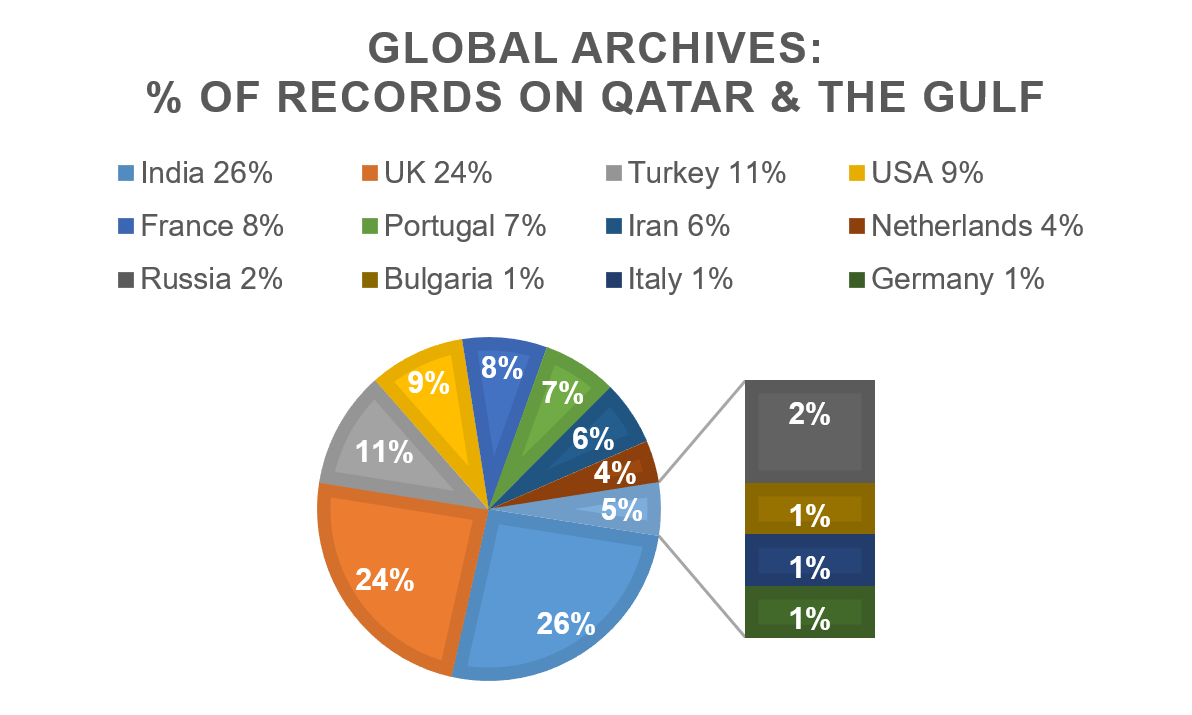Dr. Arif Shaon is Senior Digital Curation Specialist at Qatar National Library
Qatar National Library
On 16 April 2018, we were officially inaugurated as the Qatar National Library by His Highness Sheikh Tamim Bin Hamad Al Thani, the Emir of Qatar, and became one of the youngest national libraries in the world. Despite being a young library, we have taken confident steps towards supporting Qatar’s transition from a reliance on natural resources to a diverse, sustainable knowledge-based economy. Our initiative for digitally repatriating the nation’s cultural heritage, which began long before our grand opening in April, especially in the form of the Qatar Digital Library (QDL)[1], is a significant contribution to the Library’s progress.
Digital Repatriation Strategy
Since Her Highness Sheikha Moza bint Nasser, Chairperson of Qatar Foundation, announced QNL as a project in December 2012, we have been building our capacity to act as a steward of Qatar’s national heritage by collecting, preserving and making available the country’s recorded history. As a young national library, however, we have inherent challenges with building a national collection, and therefore we must look to other sources, including the collections of other, more established libraries. Because Qatar was a part of Portugal’s Indian Empire (in the 16th-17th centuries), the Ottoman Empire (during 1871-1915), the British Empire (during 1916-71), and Britain’s Indian Empire (during 1916-47), there is much historical documentation about it in Portuguese, Turkish, British, and Indian archives, as well as other archives whose countries had some sort of historical connection with Qatar – see Figure 1.

Figure 1: Historical collections pertaining to Qatar and the Gulf in global archives (source: QNL’s Historical Research and Partnerships directorate).
We have put in place a partnership strategy to collaborate with other national libraries to identify and digitize archival collections relating to Qatar and the Gulf. We aim to repatriate these records to Qatar through digitization, archival and dissemination (through QDL), with the wider goal of enabling Qataris to take ownership of their history and to encourage scholars everywhere to research and write more on the history of Qatar and its region. To ensure the long-term value of the Library’s digital repatriation work, we also have an accompanying research strategy to fund research and publish books on Qatari history based on these records, which will enable Qatar to develop and enrich its own national narrative.
Need for Digital Preservation
To date, we have made significant investments to fulfill our commitment to repatriation by acquiring increasingly large volumes of digital assets (including 2.4 M digitized files) that need to be curated and preserved adequately to ensure effective long-term accessibility and re-use. We have also invested in a modern cloud-based IT infrastructure that offers efficient data backup and archiving functions. However, case studies from the international Digital Library and other relevant communities indicate that such measures alone are not sufficient to thwart the risks of data integrity loss presented by rapid advancements in computer technology. There are many documented cases of libraries and memory organizations in other countries suffering significant data loss despite having a seemingly efficient data backup and/or archival solution in place. The data loss suffered by the University of the Balearic Islands in 2014[2] is such a case. These examples highlight the necessity of implementing suitable digital preservation solutions along with a traditional backup or archival strategy. A recently conducted review of the current state of the Library’s digital infrastructure also underlines the need for better stewardship, realized through a more robust and scalable digital environment to ensure the longevity of the significant existing assets held in the Library’s digital repository.
To address the need for preservation of our digital holdings, especially the cultural heritage collections, we have commenced a digital preservation project that, by the end of 2019, aims to lay the groundwork for implementing a complete digital preservation solution (hopefully by end of 2020), underpinned by a sound strategy that identifies and addresses key challenges.
Key Challenges
As part of the preparatory and initial phases of the digital preservation project, we conducted an investigation of the Library’s existing digital holdings and identified a number of challenges associated with implementing a suitable digital preservation solution.
Insufficient Preservation Metadata Capture
The Library has more than 10 major collections, with disparate workflows for acquisition, analysis and curation, most of which were implemented during the early stages of the Library’s development, when digital preservation was deemed out of scope. Consequently, these workflows produce inconsistently granular descriptive metadata and provide a limited scope for capturing technical—including preservation—metadata. In particular, the technical metadata generated from the digitization process are recorded inconsistently in a custom schema that may not directly interoperate with established preservation metadata standards, such as PREMIS. Those technical metadata include important provenance information pertaining to the different manual and automatic phases (assessment, scanning/imaging, image processing, quality control, optical character recognition (OCR) and packaging) of the digitization process.
Of particular note is the quality control phase of the digitization process, a complex multi-step process including semi-automated steps to ensure that every digitized page follows the Library’s established standards for a wide array of attributes of a digital image, such as image resolution, image format, color mode and bit depth, focusing, work integrity, and correct and complete page sequence. These types of information make an important contribution to the overall granularity of the preservation metadata, and hence need to be recorded, curated, preserved and disseminated in an efficient manner.
Ambiguous Copyright Provisions for Digital Preservation
The repatriation strategy of the Library involves acquiring heritage material from other countries and international donors with copyrights that may differ from the national copyright law of Qatar. The Library is permitted to make copies of these works for preservation and replacement. There is, however, ambiguity around preservation application, especially using digital technologies. We are currently working with the relevant policymakers to elicit a revision of the national copyright law to clarify these issues.
We do have a current copyright policy[3] that aims to operate within the aforementioned limitations of the national law while clarifying the ambiguities around the use of digital technologies for reprographic reproduction to cover both analog and digital methods as an institutional decision. Our copyright policy enables a case-by-case copyrights clearance process, especially for international donors, with efforts made to obtain rights that facilitate the most optimum preservation and dissemination of the material in question.
Underdeveloped Digital Repository
Our digital repository was set up in January 2016. The overall infrastructure for the digital repository is based on Islandora (version 7.x-1.6), an open-source digital content management system, integrated with Fedora Commons (version 3.8.1) as the underlying repository technology. The architecture of Islandora is based on the Drupal framework, which allows different preservation functions of a repository to be developed as Drupal modules, commonly referred to as the Islandora solution packs. Our Islandora instance, while inherently flexible, has yet to be configured to preserve, manage and provide access to different types of schema. More important, the current version of Islandora is nearing the end of its lifecycle, with Fedora version 3.8.1 now officially unsupported by Fedora Commons. Therefore, we have a significant amount of work to do in terms of migrating all our existing collections to a newer version of Islandora integrated with Fedora 4 or another system. This also presents us with an opportunity to review our current repository development policy and explore other, potentially more suitable, scalable and sustainable options.
Final Thoughts
As a young national library, Qatar National Library recognizes the importance of digital preservation for a successful repatriation program. Our digital preservation project has ambitious but realistic goals in terms of finding the right balance between the Library’s capacity and the expectations from the wider user community. A significant outcome of the project’s successful completion is that the Library will be able to build a trustworthy digital repository based on established standards in digital preservation that will facilitate its role as a legal deposit library, as well as strengthen its profile as a leading custodian of digital content in the region.
We recognize that the success of this project ultimately relies on long-term collaboration between the key Library departments to establish digital preservation as an organizational approach, rather than a departmental or a siloed one. Achieving such organization-wide synergy requires raising awareness and understanding of the importance of digital preservation, as well as eliciting commitments across the board to make an actual contribution when necessary. So far, the approval from the Senior Management Group of the Library for commencing the digital preservation project indicates that we have managed to get a top-down buy-in. There is, however, much work to do in terms of creating an understanding of and appreciation for digital preservation among the operational staff members of the Library, especially those who are directly involved with handling our digital content in some capacity. This last group includes catalogers, digitization specialists, curators and digital repository developers.
A recently conducted Open House for all Library staff showed some encouraging signs, as it attracted significant interests from the staff in learning about digital preservation and curation. For these staff, we plan to run a series of workshops and training sessions covering both theories and practices of digital preservation and curation to drive the message home.
We are also aware of the benefit of leveraging resources and expertise from the global digital preservation expert groups, such as the Digital Preservation Coalition (DPC), for developing a blueprint for a sustainable digital preservation service for the Library. As an associate member of DPC (joined in 2018), our plan for the digital preservation project and the internal staff training program includes leveraging the DPC support network as needed.
[1] An online archive that covers modern history and culture of the Gulf and wider region - www.QDL.qa
[2] Del Valle, Eduardo (2017): “Sharing my loss to protect your data: A story of unexpected data loss and how to do real preservation.” figshare. Presentation. https://doi.org/10.6084/m9.figshare.5415046.v1
[3] Qatar National Library Copyright Policy - https://www.qnl.qa/en/policies/copyright-policy













































































































































